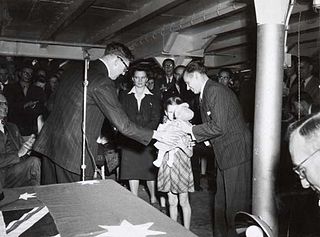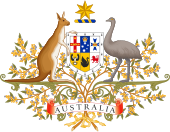
Harold Edward Holt was an Australian politician and lawyer who served as the 17th prime minister of Australia from 1966 until his disappearance and presumed death in 1967. He held office as leader of the Liberal Party of Australia.

The White Australia policy was a set of racial policies that aimed to forbid people of non-European non-white ethnic origins – especially Asians and Pacific Islanders – from immigrating to Australia in order to create a "white/British" ideal focused on but not exclusively Anglo-Celtic peoples. Pre-Federation, the Australian colonies passed many anti-Chinese immigration laws mainly using Poll Taxes, with Federation in 1901 came discrimination based on the Dictation Test, which effectively gave power to immigration officials to racially discriminate without mentioning race. The policy also affected immigrants from Germany, Italy, and other European countries, especially in wartime. Governments progressively dismantled such policies between 1949 and 1973, when the Whitlam government removed the last racial elements of Australia's immigration laws.

Arthur Augustus Calwell KC was an Australian politician who served as the leader of the Labor Party from 1960 to 1967. He led the party through three federal elections, losing each one in turn.
The immigration history of Australia began with the initial human migration to the continent around 80,000 years ago when the ancestors of Aboriginal Australians arrived on the continent via the islands of Maritime Southeast Asia and New Guinea. From the early 17th century onwards, the continent experienced the first coastal landings and exploration by European explorers. Permanent European settlement began in 1788 with the establishment of a British penal colony in New South Wales. From early federation in 1901, Australia maintained the White Australia Policy, which was abolished after World War II, heralding the modern era of multiculturalism in Australia. From the late 1970s there was a significant increase in immigration from Asian and other non-European countries.

In Canada, a security certificate is a legal mechanism by which the Canadian government can detain and deport permanent residents and all other non-citizens living in Canada.
The Immigration Restriction Act 1901 (Cth) was an Act of the Parliament of Australia which limited immigration to Australia and formed the basis of the White Australia policy which sought to exclude all non-Europeans from Australia. The law granted immigration officers a wide degree of discretion to prevent individuals from entering Australia. The Act prohibited various classes of people from immigrating and provided for illegal immigrants to be deported.

Canadian immigration and refugee law concerns the area of law related to the admission of foreign nationals into Canada, their rights and responsibilities once admitted, and the conditions of their removal. The primary law on these matters is in the Immigration and Refugee Protection Act, whose goals include economic growth, family reunification, and compliance with humanitarian treaties.

Al-Kateb v Godwin, was a decision of the High Court of Australia, which ruled on 6 August 2004 that the indefinite detention of a stateless person was lawful. The case concerned Ahmed Al-Kateb, a Palestinian man born in Kuwait, who moved to Australia in 2000 and applied for a temporary protection visa. The Commonwealth Minister for Immigration's decision to refuse the application was upheld by the Refugee Review Tribunal and the Federal Court. In 2002, Al-Kateb declared that he wished to return to Kuwait or Gaza. However, since no country would accept Al-Kateb, he was declared stateless and detained under the policy of mandatory detention.

Post-war immigration to Australia deals with migration to Australia in the decades immediately following World War II, and in particular refers to the predominantly European wave of immigration which occurred between 1945 and the end of the White Australia policy in 1973. In the immediate aftermath of World War II, Ben Chifley, Prime Minister of Australia (1945–1949), established the federal Department of Immigration to administer a large-scale immigration program. Chifley commissioned a report on the subject which found that Australia was in urgent need of a larger population for the purposes of defence and development and it recommended a 1% annual increase in population through increased immigration.

Minister of State for Immigration and Ethnic Affairs v Teoh was an Australian court case which was decided by the High Court of Australia on 7 April 1995. The case is notable for giving unprecedented significance to the ratification of international treaties by the executive government.

The Australian government has a policy and practice of detaining in immigration detention facilities non-citizens not holding a valid visa, suspected of visa violations, illegal entry or unauthorised arrival, and those subject to deportation and removal in immigration detention until a decision is made by the immigration authorities to grant a visa and release them into the community, or to repatriate them to their country of origin/passport. Persons in immigration detention may at any time opt to voluntarily leave Australia for their country of origin, or they may be deported or given a bridging or temporary visa. In 1992, Australia adopted a mandatory detention policy obliging the government to detain all persons entering or being in the country without a valid visa, while their claim to remain in Australia is processed and security and health checks undertaken. Also, at the same time, the law was changed to permit indefinite detention, from the previous limit of 273 days. The policy was instituted by the Keating government in 1992, and was varied by the subsequent Howard, Rudd, Gillard, Abbott, Turnbull, Morrison and Albanese Governments. The policy is regarded as controversial and has been criticised by a number of organisations. In 2004, the High Court of Australia confirmed the constitutionality of indefinite mandatory detention of non-citizens in Al-Kateb v Godwin. However, this interpretation was overturned in a landmark decision, NZYQ v Minister for Immigration, in 2023, with the High Court concluding the practice was unlawful and unconstitutional.

The Chifley government was the federal executive government of Australia led by Prime Minister Ben Chifley. It was made up of members of the Australian Labor Party in the Australian Parliament from 1945 to 1949.

Plaintiff M70 is a decision by the High Court of Australia. The lawsuit concerned an injunction sought by multiple Afghan asylum seekers against immigration minister Chris Bowen. The injunction was to prevent Bowen from deporting the plaintiffs to Malaysia, pursuant to s198A of the Migration Act. The purpose of the deportation was to avoid their asylum application from being assessed by Australia.
Asylum in Australia has been granted to many refugees since 1945, when half a million Europeans displaced by World War II were given asylum. Since then, there have been periodic waves of asylum seekers from South East Asia and the Middle East, with government policy and public opinion changing over the years.

The Migration Act 1958(Cth) is an Act of the Parliament of Australia that governs immigration to Australia. It set up Australia’s universal visa system (or entry permits). Its long title is "An Act relating to the entry into, and presence in, Australia of aliens, and the departure or deportation from Australia of aliens and certain other persons."

Lorenzo Abrogar Gamboa was a Filipino-American man who was excluded from Australia under the White Australia policy, despite having an Australian wife and children. His treatment sparked an international incident with the Philippines.

The Aliens Deportation Act 1948 (Cth) was an Act of the Parliament of Australia which formed part of the White Australia policy. The Act gave the government sweeping powers to deport aliens.

O'Keefe v Calwell is a High Court of Australia case.
Federal policy oversees and regulates immigration to the United States and citizenship of the United States. The United States Congress has authority over immigration policy in the United States, and it delegates enforcement to the Department of Homeland Security. Historically, the United States went through a period of loose immigration policy in the early-19th century followed by a period of strict immigration policy in the late-19th and early-20th centuries. Policy areas related to the immigration process include visa policy, asylum policy, and naturalization policy. Policy areas related to illegal immigration include deferral policy and removal policy.

Asian Australian history is the history of Asian ethnic and racial groups in Australia who trace their ancestry to Asia. The term Asian Australian, was first used in the 1950s by European Australians who wanted to strengthen diplomatic and trade ties with Asia for the benefit of the Australian community. The term was not originally used to describe or recognise the experiences of people of Asian descent living in Australia. It was only in the late 1980s and 1990s that the term "Asian Australian" was adopted and used by Asian Australians themselves to discuss issues related to racial vilification and discrimination. Today, the term "Asian Australian" is widely accepted and used to refer to people of Asian descent who are citizens or residents of Australia, though its usage and meaning may vary within the Asian Australian community.









